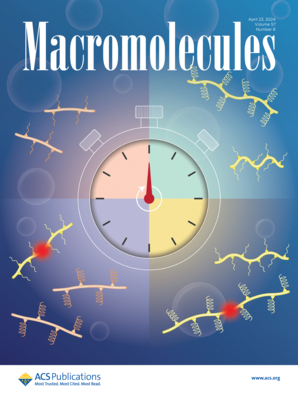l-lysine Efficiently Polymerizes with CO2 under Mild Conditions for Biocompatible Fluorescent Polyurea
IF 5.1
1区 化学
Q1 POLYMER SCIENCE
引用次数: 0
Abstract
Polymerization of CO2 into polyurea under mild pressure and temperature is still a challenge, especially when using diamine from natural feedstocks. Herein, l-lysine is directly used as a diamine without derivatization and protection for capture and copolymerization of CO2 under mild temperatures and pressures (0.1–0.5 MPa, 60–90 °C) with the assistance of superbase 1,8-diazabicyclo[5.4.0]undec-7-ene (DBU). Water-soluble lysine-polyurea (L-PU) has been synthesized. The weight-average molecular weight of L-PU reaches 3 × 104 g/mol, indicating the efficient reaction of lysine and CO2. In addition, NMR studies confirmed that the unprotected carboxyl acid group (−COOH) in L-PU remains more than 80%, and the polymer may be a candidate to replace nonbiodegradable polyacrylate acid (PAA). The free carboxyl acid group also provides a change to further derivatives of the L-PU. Interestingly, the water-soluble L-PU showed efficient fluorescence performance with quantum yield (QY) up to 20%, which may be attributed to the nonconventional intrinsic fluorescence of nonconjugated aliphatic polyureas containing heteroatoms. It allows the L-PU to be used for cell bioimaging, and in vitro studies reveal that the L-PU is biocompatible and can be efficiently endocytosed by cells with bioimaging ability, indicating that it may be a potential drug delivery system for imaging-guided treatment for cancer tissue.

求助全文
约1分钟内获得全文
求助全文
来源期刊

Macromolecules
工程技术-高分子科学
CiteScore
9.30
自引率
16.40%
发文量
942
审稿时长
2 months
期刊介绍:
Macromolecules publishes original, fundamental, and impactful research on all aspects of polymer science. Topics of interest include synthesis (e.g., controlled polymerizations, polymerization catalysis, post polymerization modification, new monomer structures and polymer architectures, and polymerization mechanisms/kinetics analysis); phase behavior, thermodynamics, dynamic, and ordering/disordering phenomena (e.g., self-assembly, gelation, crystallization, solution/melt/solid-state characteristics); structure and properties (e.g., mechanical and rheological properties, surface/interfacial characteristics, electronic and transport properties); new state of the art characterization (e.g., spectroscopy, scattering, microscopy, rheology), simulation (e.g., Monte Carlo, molecular dynamics, multi-scale/coarse-grained modeling), and theoretical methods. Renewable/sustainable polymers, polymer networks, responsive polymers, electro-, magneto- and opto-active macromolecules, inorganic polymers, charge-transporting polymers (ion-containing, semiconducting, and conducting), nanostructured polymers, and polymer composites are also of interest. Typical papers published in Macromolecules showcase important and innovative concepts, experimental methods/observations, and theoretical/computational approaches that demonstrate a fundamental advance in the understanding of polymers.
 求助内容:
求助内容: 应助结果提醒方式:
应助结果提醒方式:


